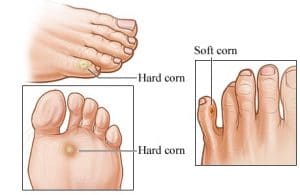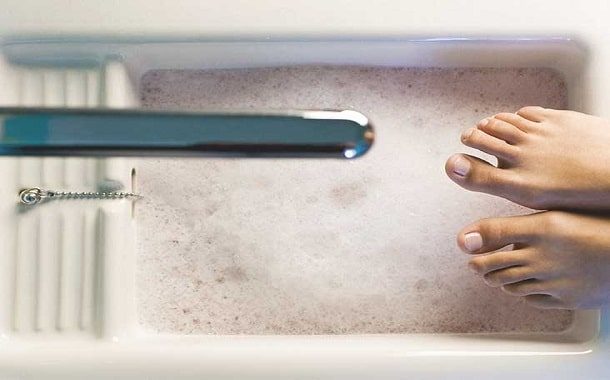How Much Does Foot Corn Removal Surgery Cost?
Last Updated on February 28, 2024
Written by CPA Alec Pow | Content Reviewed by ![]() CFA Alexander Popinker
CFA Alexander Popinker
Foot corns can cause immense pain and discomfort. Although there are home remedies to temporarily alleviate corn pain, most severe cases require surgical removal for permanent relief. If you’re considering foot corn removal surgery, it is likely you’re also wondering – how much does it cost?
The total cost depends on several key factors, which we will explore in depth below. As soon as you understand what makes up the price of corn removal surgery, you can better budget and prepare for this potentially $500 to $3,000 procedure.
Weighing the pros and cons of surgery versus home treatment can help you make the best choice for your foot health and finances.
How Much Does Foot Corn Removal Surgery Cost?
The main expenses that contribute to the overall cost of corn removal surgery include:
- Consultation Fees: The first step is meeting with a podiatrist or dermatologist for an exam, usually $100 to $300. They will determine if you are a candidate for surgery.
- Surgeon and Surgical Center Fees: The surgery itself costs $500 to $2000+. This covers the podiatric surgeon, medical team, operating room, equipment, medication, and surgical supplies. More complex surgeries are typically more expensive.
- Anesthesia Fees: For “twilight sleep” sedation or general anesthesia, expect to pay $200 to $1000 extra. Local anesthesia is the cheapest option but may not be suitable for larger surgeries.
- Follow-up Appointments: Postoperative checkups are crucial and usually cost around $100 to $200 per visit. You may need 2-4 visits in the first couple months after surgery.
- Medication and Medical Equipment: Antibiotics, pain medication, orthotics, special shoes, creams etc can run $100 to $500+. Your particular recovery needs will determine costs.
- Medical Insurance Coverage: This can lower your out-of-pocket fees anywhere from 20% to 80%+. But insurance does not cover 100% of costs in most cases. We’ll explore this next.
Luxe Foot Surgery writes that the cost of corn removal surgery typically ranges from $500 to $1,000 per corn. Additional follow-up appointments or treatments may increase the overall cost. Factors influencing the price include the severity of the corn, its location, and other individual considerations.
Insurance Coverage and Foot Corns
The right medical insurance plan can significantly offset the financial burden of foot corn surgery. Here’s how to make the most of your coverage:
- Check if corn removal is a covered benefit – some policies only cover medically necessary procedures.
- Look for podiatry coverage – standard health plans may have limited benefits.
- Compare out-of-pocket costs – plans may have different deductibles, copays, and coinsurance.
- Consider getting preapproval – your insurer can confirm coverage amounts beforehand.
- Review claim denials carefully – you can appeal if the denial seems unjustified.
- Ask about payment plans – many providers offer interest-free installments.
While insurance is helpful, you’ll likely still have hundreds to thousands in out-of-pocket medical bills to pay. Planning ahead is key to avoiding financial stress.
Financial Preparation and Budgeting Tips
Since foot corn removal often costs $1500+ out-of-pocket on average, you’ll want to start budgeting early if surgery is necessary:
- Save incrementally – set aside $50 or $100 per paycheck in a dedicated account.
- Look into financing – some providers offer 0% financing if you qualify.
- Apply for financial assistance – nonprofit organizations or the surgeon may offer help.
- Use tax-advantaged accounts – HSAs and FSAs can help cut costs.
- Request payment plans – many medical providers offer monthly installments.
- Cut discretionary costs – trim expenses like dining out or subscriptions temporarily.
- Consider getting a second opinion – this can reveal less expensive options.
With strategic planning, you can make foot corn surgery affordable. The investment will be worthwhile if surgery relieves your pain long-term.
Also, check out the price of hammertoe surgery, Brachymetatarsia surgery, and bunion surgery.
Surgical Techniques: Pros and Cons
There are several methods for removing bothersome corns on the feet:
Scalpel Surgery
- A podiatrist uses a scalpel to cut out the entire corn down to the root.
- Over 90% success rate, but risk of infection and recurrence.
- Requires stitches and has a long, painful recovery. Not ideal for large or numerous corns.
Laser Treatment
- A concentrated laser beam vaporizes and destroys the corn.
- Precise, with excellent cosmetic results and fast healing.
- Less tissue damage than scalpel method, allowing quicker return to normal activity.
- The high-tech equipment involved makes this option more expensive.
Cryotherapy
- Liquid nitrogen is applied to freeze and kill corn cells.
- Minimal pain, fast recovery. No need for anesthesia.
- Works best for mild, superficial corns. May require multiple treatments.
- Affordable, costing around $200 per session. Best value for small corns.
Talk to your doctor about which technique is best suited for your specific case. Weigh the pros and cons versus your budget.
Recovery Timeline and Postoperative Care
Healing and recovery time differs for each foot corn removal technique:
- Scalpel surgery requires wearing a surgical shoe and restricts walking for 2-4 weeks. Follow-up appointments continue for 2-3 months.
- With laser surgery, you can resume light activity after 1-2 weeks and normal exercise after 4 weeks. Some pain and tenderness may remain for a couple months.
- For cryotherapy, the foot is sore for 2-3 days but you can walk normally right away. Use molefoam padding on the area for 1 week and avoid soaking the foot.
 Proper postoperative care is crucial for minimizing infection risk and encouraging proper healing after any technique. Be sure to:
Proper postoperative care is crucial for minimizing infection risk and encouraging proper healing after any technique. Be sure to:
- Elevate feet above heart level as much as possible
- Keep feet clean and dry
- Apply antibiotic ointment daily
- Take prescribed pain medication as directed
- Wear recommended orthotics or post-op shoes
- Attend all follow-up appointments for wound checks
See your doctor promptly if you experience bleeding, swelling, redness, oozing, or fever as these are signs of potential complications. Avoid bumping or injuring the site until fully healed.
Patient Reviews: Satisfaction and Success Rates
Patients who undergo foot corn removal surgery report:
- Significant pain relief – over 90% saw a great improvement in symptoms.
- High satisfaction – 80-85% very pleased with the results and would recommend it.
- Improved mobility – able to walk and exercise without discomfort.
- Permanent correction – fewer than 15% saw corns return or recur after 5 years.
- Easy recovery – most were able to resume normal work and activity within 1 month.
- Minor side effects – some numbness, tenderness, swelling, or scarring.
- Few complications – when follow-up care instructions are followed, serious risks are very low.
Overall, the success rates for permanent corn removal are approximately 85-90% when performed by an experienced podiatric surgeon. The majority of patients are glad they underwent surgery to resolve their painful corns.
Final Words
While foot corn surgery can be an effective solution for persistent, painful corns, prevention is always preferable. Try these proactive tips to avoid developing corns in the first place:
- Wear properly fitted shoes with cushioned insoles and wide toe boxes
- Use toe spacers and pads to minimize friction and pressure
- Apply moisturizing foot creams to soften skin and calluses
- Get pedicures to gently remove thickened skin
- Take over-the-counter corn removal medication early
- See a podiatrist at the first sign of corn pain for early treatment
Catching corns early and being proactive with foot health makes surgery less likely to be necessary. But if home care fails to provide relief from debilitating corns, surgical removal may still be your best option for long-term comfort.
Frequently Asked Questions
Is corn removal surgery worth it?
For those suffering from severe, recurring corn pain that hasn’t improved with conservative treatment, surgery is often very worthwhile. It can provide permanent relief when performed correctly.
Over 90% of patients report satisfaction with the results. The initial surgical and recovery cost is a good investment to resolve the problem for good.
Does insurance cover corn removal?
Some health insurance plans do cover foot corn removal, especially if deemed medically necessary. But the extent of coverage varies widely. Typical policies cover 50-80% of costs after the deductible is met.
Those with podiatry benefits have the best coverage. It’s wise to verify your actual benefits in advance so you can budget accurately.
Can a podiatrist remove a corn permanently?
Yes, when an experienced podiatrist performs the corn removal surgically, there is approximately an 85-90% chance of complete, permanent removal. The key is extracting the entire root of the corn so it cannot grow back.
Proper postoperative care also reduces recurrence risk. Occasionally, some thickening of the skin may remain, but this is manageable with consistent foot care.


Leave a Reply
Want to join the discussion?Feel free to contribute!